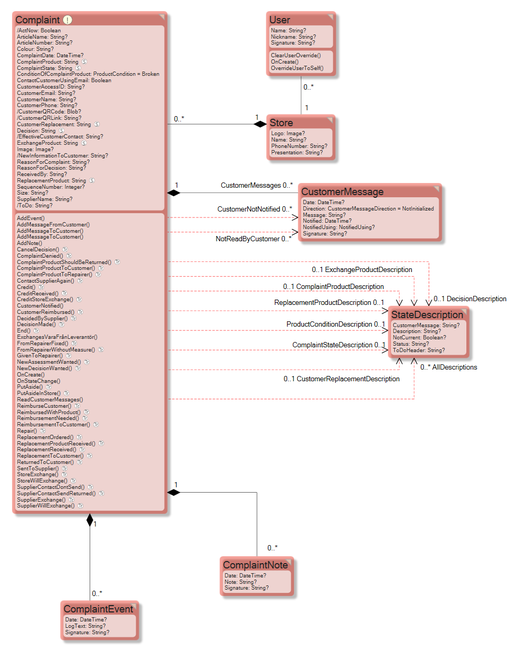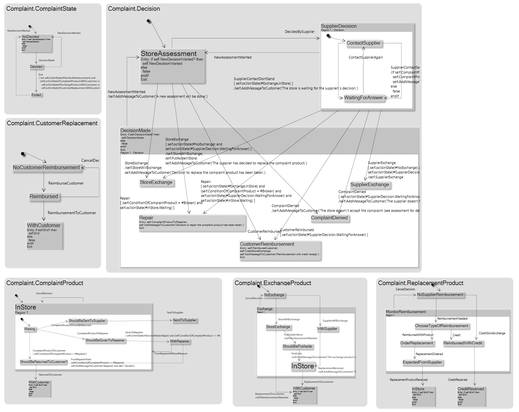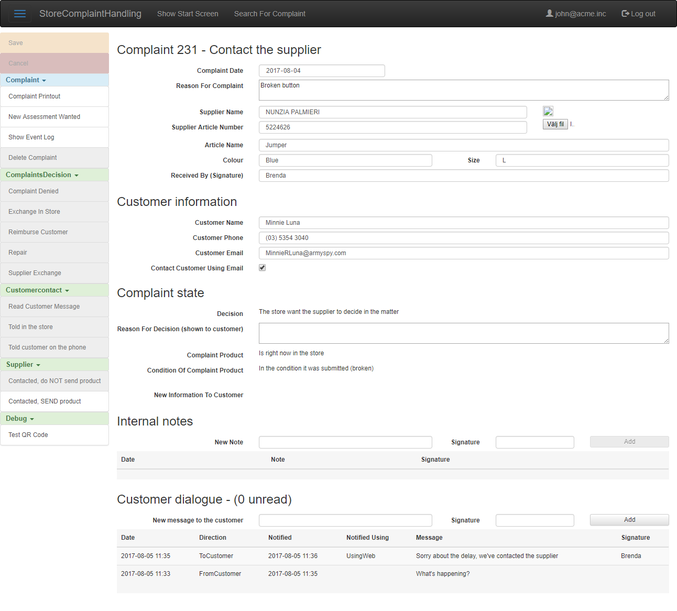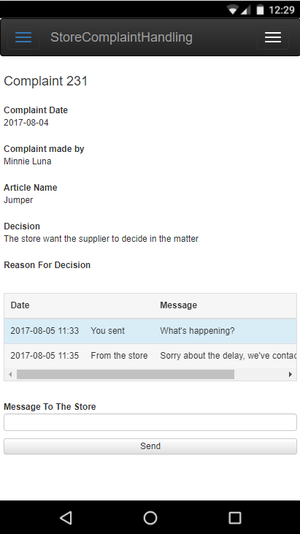Store complaint handling
No edit summary |
(Adding page to Category:TOC because it contains a TOC.) |
||
| (10 intermediate revisions by 3 users not shown) | |||
| Line 1: | Line 1: | ||
=== What is it? === | === What is it? === | ||
'''Handling | '''Handling Customer Complaints for a Store''' | ||
This is | This is the complete app, model, and example data for a clothing shop, to help staff handle customer complaints professionally. | ||
[[File:ComplaintTrackerStartScreen.png|none|thumb|853x853px]] | [[File:ComplaintTrackerStartScreen.png|none|thumb|853x853px]] | ||
=== How to use === | === How to use it === | ||
The MDriven database image contains, in addition to the model, the following | The MDriven database image contains, in addition to the model, the following: | ||
# User interface messages for all states | |||
# Two users | |||
#* john@acme.inc (store employee) | |||
#* admin@acme.inc (system manager) | |||
#* The password is "password" for both users | |||
# 200 fake complaints in various states of handling | |||
# MDrivenServer log-on | |||
#* User: "a" | |||
#* Password: "password" | |||
=== | === Download === | ||
You can download the complete database copy here: [[File:StoreComplaintHandling.zip]] | |||
=== Key | === Key Features (For Users) === | ||
# Complaint tracking | |||
# Tracking what information has reached the customer | |||
# Internal notes | |||
# Customer chat using QR-code for easy customer access | |||
# Tracking the following use cases: | |||
#* The complaint process' current state | |||
#* Decision process: | |||
#** Store decision | |||
#** Supplier decision | |||
#** Manager decision | |||
#* Where the broken product is (complaint product) | |||
#* A replacement product (from the supplier) | |||
#* Exchange product (from supplier or store) | |||
#* Reimbursement for the customer | |||
#* Reimbursement from the supplier to the store | |||
#* Credit tracking | |||
# Staff to-do list | |||
# User editable messages | |||
# Automatic event tracking | |||
# Multiple stores | |||
#* Address information | |||
#* Logo | |||
=== Key Features (For Developers) === | |||
* Very complex setup of state machines | * Very complex setup of state machines | ||
* Summary views | * Summary views | ||
| Line 44: | Line 50: | ||
* User management views | * User management views | ||
* User rights setup | * User rights setup | ||
* Derived to ease user interface creation | * Derived attributes and associations to ease user interface creation | ||
* | * Uploading and showing images | ||
* Automatic logging on state changes | * Automatic logging on state changes | ||
* Binding information to state machines (messages in this example) | * Binding information to state machines (messages in this example) | ||
* Serverside assignment of numbering | * Serverside assignment of numbering | ||
* QR-code setup for linking to | * QR-code setup for linking to applications | ||
* Printing setup of | * Printing setup of ViewModel | ||
* AngularJS dynamic styling | * AngularJS dynamic styling | ||
=== Content | === Content Examples === | ||
[[File:StoreComplaintHandling, main classes.png|657x657px|Main classes|none|thumb]][[File:StoreComplaintHandling, state machines.png|519x519px|State machines|none|thumb]] | [[File:StoreComplaintHandling, main classes.png|657x657px|Main classes|none|thumb]][[File:StoreComplaintHandling, state machines.png|519x519px|State machines|none|thumb]] | ||
[[File:StoreComplaintHandling, Complaint view.png|none|thumb|677x677px|Complaint view]] | [[File:StoreComplaintHandling, Complaint view.png|none|thumb|677x677px|Complaint view]] | ||
| Line 59: | Line 65: | ||
[[Category:Case]] | [[Category:Case]] | ||
[[Category:Example]] | [[Category:Example]] | ||
{{Edited|July|12|2024}} | |||
[[Category:TOC]] | |||
Latest revision as of 14:13, 26 March 2024
What is it?
Handling Customer Complaints for a Store
This is the complete app, model, and example data for a clothing shop, to help staff handle customer complaints professionally.
How to use it
The MDriven database image contains, in addition to the model, the following:
- User interface messages for all states
- Two users
- john@acme.inc (store employee)
- admin@acme.inc (system manager)
- The password is "password" for both users
- 200 fake complaints in various states of handling
- MDrivenServer log-on
- User: "a"
- Password: "password"
Download
You can download the complete database copy here: File:StoreComplaintHandling.zip
Key Features (For Users)
- Complaint tracking
- Tracking what information has reached the customer
- Internal notes
- Customer chat using QR-code for easy customer access
- Tracking the following use cases:
- The complaint process' current state
- Decision process:
- Store decision
- Supplier decision
- Manager decision
- Where the broken product is (complaint product)
- A replacement product (from the supplier)
- Exchange product (from supplier or store)
- Reimbursement for the customer
- Reimbursement from the supplier to the store
- Credit tracking
- Staff to-do list
- User editable messages
- Automatic event tracking
- Multiple stores
- Address information
- Logo
Key Features (For Developers)
- Very complex setup of state machines
- Summary views
- Login handling
- User management views
- User rights setup
- Derived attributes and associations to ease user interface creation
- Uploading and showing images
- Automatic logging on state changes
- Binding information to state machines (messages in this example)
- Serverside assignment of numbering
- QR-code setup for linking to applications
- Printing setup of ViewModel
- AngularJS dynamic styling
Content Examples
This page was edited 56 days ago on 03/26/2024. What links here




